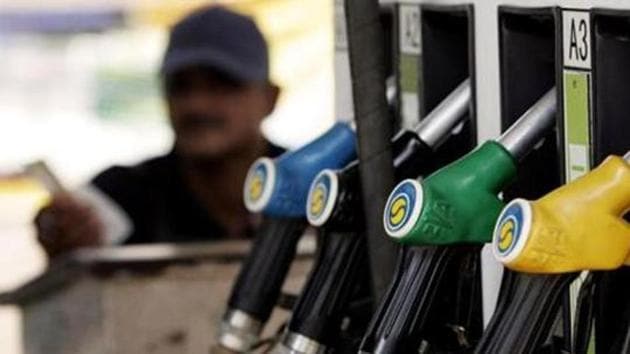Jokes on 1-paise cut in fuel price notwithstanding, govt will have to bite the bullet sooner than it wishes to
Elevated oil prices will mean higher inflation, which, in turn, will add to the pressure on the rupee. Subdued exports growth and rising import costs have already weakened the rupee by more than 6% in the past three months
After increasing the retail prices of petrol and diesel for 16 straight days, state-run oil marketing companies announced a one paisa per litre cut, effective Wednesday, making the government a butt of jokes. As consumers took to social media to vent their anger and frustration, opposition parties mounted a fresh attack on the government for dragging its feet over an issue that needs urgent intervention.

“If this is your idea of a prank, it’s childish and in poor taste,” Congress President Rahul Gandhi said in a tweet addressed to Prime Minister Narendra Modi. “P.S. A ONE paisa cut is not a suitable response to the ‘Fuel Challenge’ I threw you last week,” Gandhi said.
It is rather intriguing that, apart from a token cut in the excise duty rates, the government has so far adopted a wait-and-watch approach on the rising oil prices that have serious economic and political consequences. It appears that the government is placing its best bet on the hope that international crude prices will recede in time in the same way it rose.
On Tuesday, Brent crude futures moderated marginally by 6 cents to $75.24 barrel. Despite the intent of Saudi Arabia and Russia and the sustained increase in oil exports from the United States, there still remain strong reasons for a continued push for higher crude prices through the coming months.
First, the members of the Organization of the Petroleum Exporting Countries (OPEC) and Russia still have to conclude on whether they will indeed increase their production output when they meet in Vienna on June 22.
Second, Saudi Arabia’s State-run oil company Saudi Aramco is expected to list its shares on the international stock exchanges by the end of 2018 or in early 2019. For a successful initial public offer (IPO), billed as the world’s biggest ever, Saudi Arabia has a vested interest in keeping oil prices moderately high.
Last, the festering economic and political crisis in Venezuela continues to pose serious upside risks to oil prices. The South American country, which once ranked among the world’s top five oil exporters, has slipped several notches as its oil production almost halved in the past two years, hurting global supplies and pushing up prices.
In the current scenario, most analysts expect crude prices to stay in the range of $70-$80 per barrel, at least until the end of 2018. And that is clearly not good news for India. Compared to last year, such a price band amounts to a 25%-40% increase in dollar-denominated crude imports for India. And if we add to it the impact of a depreciating rupee, then the cost of crude will continue to hit consumers hard, unless the Indian government is willing to go in for a major cut in taxes.
Duty Cuts: How far can the government go?
Thus far, neither the Centre nor the states have been able to reduce the duties they levy on petrol and diesel because these bring in much-needed revenue at a time when tax collections from other sources have turned sluggish.
More than 50% of what the consumer pays for petrol or diesel is pocketed by the government. As of now petrol and diesel, which are not covered under GST, continue to attract a road development cess, a central excise duty and a state-level value-added tax.
While bringing the fuels under GST might make them cheaper, such a step isn’t going to be easy, especially in the current political and economic environment. For petrol and diesel to be brought under GST, all states have to come on board and the GST council has to figure a rate that doesn’t end up profoundly altering the delicately poised fiscal arrangements between the Centre and the states.
Even if the road development cess is retained and the highest rate of GST of 28% is applied to petrol and diesel, it would still leave both the Centre and the states with a huge revenue shortfall. Introducing a new and higher GST rate goes against the government’s commitment to reduce the number of tax slabs from five to three over the next two years.
More than the difficulties of figuring out an optimal rate, the real challenge lies in overcoming the resistance from the states. Few of the states believe they have benefitted from signing up for GST since last July. For many, the rising oil prices have in fact brought in incremental revenues which are badly needed in an election year, to fund populist schemes.
In short, petrol and diesel under GST isn’t going to happen soon. For now, their prices are likely to stay elevated.
The implications are obvious.
Elevated oil prices will mean higher inflation, which, in turn, will add to the pressure on the rupee. Subdued exports growth and rising import costs have already weakened the rupee by more than 6% in the past three months. And to make things worse, capital outflows are rising at a faster pace. In May itself, foreign portfolio investors have pulled out nearly ₹27,000 crore from equities and debt, which is the highest in past one-and-a-half years.
All of these will likely guide the Reserve Bank of India to go for monetary tightening earlier than expected. It will thus not be surprising if the monetary policy committee (MPC) settles for a repo rate hike when it meets this coming Monday.
In sum, in the current scenario of rising oil prices, the cure in India might be more dreadful than the disease. Either way the government will have to bite the proverbial political bullet very soon rather than allow itself to be held hostage to indecision.
Twitter: @rajeshmahapatra






